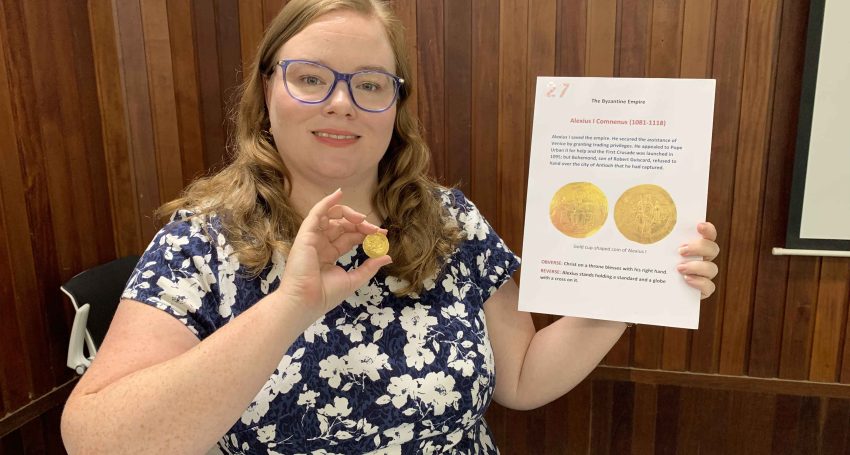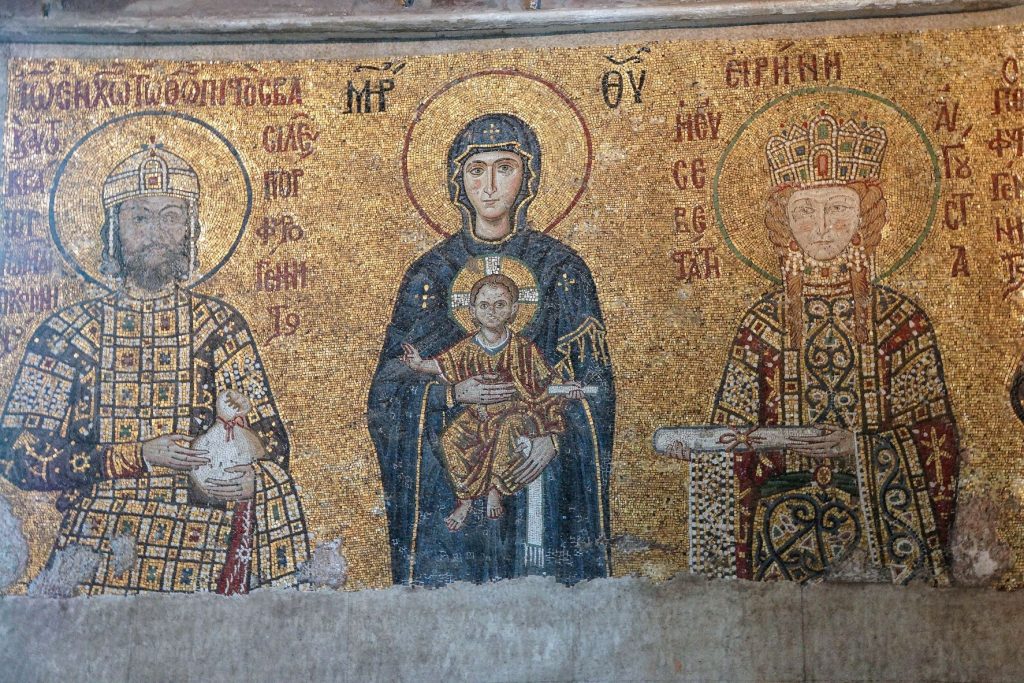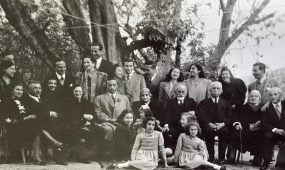A coin is worth a thousand words
People & History
“In the ancient coins, lamps, manuscripts, marble statues, and mosaics that remain, the imagery and imagination of a distant time and place can be found again, allowing us to find new ways to tell the stories of the past for the present,” says Dr Sheilagh Ilona O’Brien, with The Rev’d Dr Gregory Jenks

“The past is a foreign country; they do things differently there,” declared author L.P. Hartley in The Go-Between, in one of the finest opening lines in English literature since Charles Dickens declared “It was the best of times, it was the worst of times…”
I used to travel overseas quite a lot and the little alloy tokens that we used to purchase a train ticket or pay for a taxi ride were a source of fascination and frustration. In a tangible way they told us just how foreign we were to the place we were visiting. Coins are material products of a culture that can offer discerning eyes a glimpse of another country’s story – or at least the story it wants to tell you about itself.
Historical coins offer us a similar glimpse into a different kind of foreign country, and one that we cannot still visit. They are a tangible link to a past that is profoundly different from our present and seems ever further away from our modern experience.
Today we tap a card or use a phone app to make purchases, but for more than two-and-a-half thousand years, the most common form of currency in much of the world was the humble “coin”. And those coins came in many forms in different places. We might think only of shiny metal coins that we associate with ancient China, Europe, the Near East or North Africa, but in Oceania shell money was far more popular.
Coins, whatever they are made of, do not usually carry microchips and cannot be used for late night online shopping binges, but they are often well-preserved in archaeological sites across the world and offer us their own stories about the past.
They are pieces of art, statements of power, tools of propaganda – and a way to buy a loaf of bread – all in one.
They can tell us how the people who made them wanted the world to see them. Roman emperors used the symbols on their coins to project power and prestige. But over time the coins they produced tell a story of how that image of power, and the beliefs those in power, changed. For example, coins can chart the shift from pagan Rome to Christian Rome through their changing iconography – or even the iconography’s change in meaning.
Advertisement
The images of Jupiter or “winged Victories” found on the reverse of imperial coinage in the early Christian era gave way slowly to the Christian imagery of Christ across the fourth century. And of course, the Victories themselves went through their own evolution. From the Greek goddess Nike, the latinised goddess Victoria as a pair of “Victories”, to the heavenly hosts – angels.
In the new St Francis College unit Telling History: Introduction to Church History, coins from the Centre for Coins, Culture and Religious History at St John’s Cathedral are being used to enrich our students’ understanding of the past. Students in the course will be invited to present on a topic involving a material object, and they will be able to choose from a wide range of coins, lamps, and manuscripts provided by the Centre for Coins, Culture and Religious History.
In this course students will examine several case studies from across Christian history, from early Christian apologetical writings to contemporary debates about the role of religion in society. In the second case study in the course, students will read extracts from The Alexiad by Anna Comnena (Anna Komnene). Anna was the daughter of the Byzantine emperor Alexius I Comnenus (Komnenos) and is sometimes called the first female historian.
Anna was “born to the purple”, quite literally, having been born to her mother Irene Doukaina in the Porphyra Chamber of the imperial palace in Constantinople, which Anna described in The Alexiad. Anna’s father had become emperor two years earlier. Anna was the eldest of his children and his co-heir until her younger brother John could be named as his father’s heir (after the death of their father, John imprisoned his sister in a monastery for attempting to seize the throne).

Comnenos mosaic (John II Komnenos and empress Irene standing beside the Virgin Mary holding the Child Christ) in Hagia Sophia, Istanbul, Turkey
Alexius I Comnenus is best remembered now for his continuous military struggle to halt the collapse of the Byzantine Empire and, in the west, for initiating the First Crusade (1096-1099).
Anna’s Alexiad is the best source we have for her father’s life and is a first-hand account of the First Crusade from a Byzantine perspective. It also extensively discusses the role of women in the Byzantine court, including Anna’s powerful grandmother, Anna Augusta Dalassene, and Anna’s own mother, Irene Doukaina, who supported her daughter’s claim to the imperial throne.
Advertisement
The Centre for Coins, Culture and Religious History’s collection includes coins that were minted by Anna’s father, Alexius, and her brother, John.
The coins issued by Alexius and his son have a similar shape and iconography.
The emperor is shown on one side – just as had been the case in the first century when Jesus asked whose head was on the coin and tells his followers to “render unto Caesar what belongs to Caesar” (Mark 12.15). On the other side of many Roman coins an image of a god or goddess would be displayed – for example the defied Augustus was found on the so-called “tribute penny” referenced in Mark 12.15.
But in the place of Augustus or Jupiter, or winged Victories, the Comnenus emperors coins that we have at the Centre for Coins, Culture and Religious History have Christ on the obverse, portrayed as the Pantokrator (ruler of all), seated on a throne.
On Alexius’ coin, the King of Kings offers a blessing, while on John’s coin he holds the gospel book.
The coins of this period are notable for their “scyphate” or “cup” shape. Rather than being flat, they are convex discs. This may have been a device to confound potential counterfeiters. The coins of this period were also “debased” in that the gold coinage had reduced gold purity. By the time Alexius I Comnenus became emperor, the coinage was no longer struck in gold and one of his important reforms was replacing the “billon” coins, which used a cheap alloy of base metals with minimal gold or silver, with a mixture of copper and silver in a new concave gold coin, the hyperpyron.
The John coin shown here is made of “billon”. It is easy to see the difference between the dull copper-silver alloy of John’s coin, and the golden hyperpyron of Alexius.

“The John coin shown here is made of “billon”. It is easy to see the difference between the dull copper-silver alloy of John’s coin, and the golden hyperpyron of Alexius,” (Dr Sheilagh O’Brien, with a coin from the Centre for Coins, Culture and Religious History collection, which is on display at St John’s Cathedral)
Like these two coins – one shiny and bright, one dull and damaged – the period of Anna’s life was tumultuous. You might say it was the best of times for the Comnenus family as Anna’s father managed to establish a dynasty that would last a century. But it was also the worst of times.
Constantinople had thought its western allies might help restore their lost territories in Anatolia, and even recapture the Holy Land for the Empire – Jerusalem itself had been lost more than three hundred years earlier.
The leaders of the First Crusade pledged fealty to Alexius in Constantinople and swore that they would return his lost lands to him in exchange for supplies and monetary support from the Emperor.
Instead, they claimed the lands for themselves. Over the next century, the Crusader States proved in some ways to be as troublesome a set of neighbours as the Seljuq Sultanate.
Shortly after the Comnenus dynasty lost power in Constantinople, the city was sacked by the Fourth Crusade in 1204 – a western Christian army that had been called upon to save the city of Jerusalem looted the holy sites of the second Rome, destroying and defacing churches, monasteries, and convents. The crusaders even melted down bronzes, like the famous Farnese Hercules by Lysippos that Alexander the Great had commissioned in the fourth century B.C.E.
The destruction of the city and the splintering of the empire was a brutal blow to Byzantium’s prestige and power from which it would never recover. In some ways, the golden coin of Alexius I Comnenus is symbolic of the last great Byzantine dynasties. It’s a tiny piece of art that captures a moment in time, when Byzantium struggled for its own survival and briefly hoped that an alliance with western “Christendom” might re-unite the faith and restore the Holy Land to the empire.
These moments are recapturable in the ancient coins, lamps, manuscripts, marble statues, and mosaics that remain. They show us the imagery and imagination of a distant time and place and allow us to find new ways to tell the stories of that distant past for our present.
Editor’s note: If you found this feature interesting and you would like to know more about studying at St Francis College or about the Semester 1 2023 subject ‘CH1001Z/CH8001Z: Telling History: Introduction to Church History’, please visit the St Francis College website or contact the Dean of Students, Dr Sheilagh O’Brien, on 07 5514 7403 or via sheilagh.obrien@anglicanchurchsq.org.au
If you are interested in seeing more coins from the Collection, please visit The Cathedral Coins at St John’s Anglican Cathedral or visit their online exhibitions. For further information, contact the Centre for Coins, Culture and Religious History.





